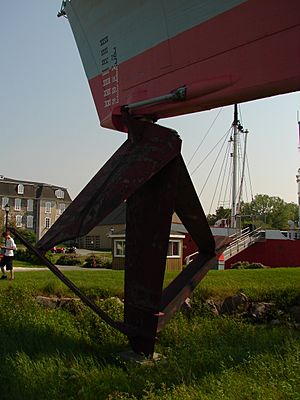HMCS Bras d'Or (FHE 400) facts for kids

HMCS Bras d'Or at the Musée maritime du Québec, L'Islet-sur-Mer
|
|
| History | |
|---|---|
| Namesake | Bras d'Or Lake |
| Ordered | 1960 |
| Builder | Marine Industries Limited, Sorel-Tracy, Quebec |
| Laid down | 1963 |
| Launched | 12 July 1968 |
| Commissioned | 23 July 1968 |
| Decommissioned | 2 November 1971 |
| Status | Museum ship |
| Badge | Azure, issuing from a base barry wavy of four argent and azure, an arm embowed or, the hand grasping a pheon-headed spear in bend sinister pointed to the dexter argent |
| General characteristics | |
| Type | Hydrofoil |
| Displacement | 240 t (236 long tons) |
| Length | 49.95 m (163 ft 11 in) |
| Beam | 66 ft (20 m) main foil span |
| Propulsion |
|
| Speed | 60 knots (110 km/h; 69 mph) |
| Range |
|
| Complement | 25 (7 officers, 6 petty officers, 12 men) |
| Armament | None |
HMCS Bras d'Or (FHE 400) was a special type of ship called a hydrofoil. It served in the Canadian Forces from 1968 to 1971. A hydrofoil is a boat that lifts itself out of the water using wing-like structures called foils. This allows it to travel much faster.
During its tests in 1969, Bras d'Or reached speeds over 63 knots (117 km/h; 72 mph). This made it the fastest unarmed warship in the world at that time. It was built to test new ways to find and fight enemy submarines.
The ship was named after Bras d'Or Lake in Nova Scotia. This lake is famous because Alexander Graham Bell, the inventor of the telephone, did his own hydrofoil experiments there. He even set a world watercraft speed record! The lake was also where the first airplane in Canada flew, the AEA Silver Dart. So, the name Bras d'Or was perfect for a ship that could "fly" above the water.
Contents
Building a Super-Fast Ship
Bras d'Or was built at Marine Industries Limited in Sorel, Quebec. The main company in charge was de Havilland Canada, which usually builds airplanes. The ship's body was made from aluminum. It was built upside down and then flipped over in 1966.
The special foils that lifted the ship were made from a strong type of steel called maraging steel. These foils were coated with rubber to stop them from rusting, but it didn't work perfectly.
Bras d'Or used a unique foil design. It had a small foil at the front and a larger one at the back. The front foil was shaped like a diamond and could be steered.
The ship had two different engine systems. One was for when it was "foilborne" (flying above the water). This system used a powerful gas turbine engine, like a jet engine, that made 25,500 horsepower (19.0 MW). The other system was for "hullborne" travel (when it was floating like a normal boat). This used a diesel engine.
In 1966, there was a fire during construction due to a fuel leak. This caused delays and cost a lot of money. The ship was finally launched on July 12, 1968.
Amazing Speed Trials
Bras d'Or first "flew" on April 9, 1969, near Halifax Harbour. It was very stable even in rough seas. It was more stable at 40 knots (70 km/h; 50 mph) than a regular ship at 18 knots (33 km/h; 21 mph).
During its tests, Bras d'Or went faster than 63 knots (117 km/h; 72 mph). This made it possibly the fastest warship ever built! However, it never had any weapons installed. Today, the fastest armed warships are the Norwegian Skjold-class corvettes, which can go 60 knots (110 km/h; 70 mph).
Why Was It Cancelled?
The testing program for Bras d'Or was stopped suddenly on November 2, 1971. The government decided to change its focus from fighting submarines to protecting Canada's borders.
The ship was kept in storage for five years. Then, the project was completely cancelled by the government. Most of its valuable parts were sold or scrapped.
Where is it Now?
Luckily, the ship itself was saved! It was given to the Musée Maritime du Québec (Quebec Maritime Museum) in L'Islet-sur-Mer, Quebec. You can still see it on display there today.
Remembering Bras d'Or
Even though the ship is no longer in service, its memory lives on. The Royal Canadian Sea Cadets Corps Bras d'Or (#268) in Quispamsis, New Brunswick, is named after the ship. This cadet group helps young people learn about the navy and develop leadership skills.


